If you have seen a White-Tailed Sea Eagle in Ireland, Please send us details via the Glengarriff Nature Reserve website.
Note: Information on the birds' locations may be sensitive and we will not share information on sightings without your permission.
In 2020, the National Parks and Wildlife Service began a second phase white-tailed eagle reintroduction project to bolster the existing eagle population in Ireland. The original reintroduction programme (2007-2011) involved releasing 100 young white-tailed eagles in Killarney National Park, County Kerry. The released eagles subsequently dispersed widely throughout Ireland with the first successful breeding occurring in 2012 on Lough Derg, County Clare. By July 2020, a small breeding population of eight to ten pairs had successfully fledged 31 chicks across counties Cork, Kerry, Clare, Galway and Tipperary.
Some Irish-bred eagles are now reaching maturity and starting to breed in the wild. However, a scientific review of the reintroduction project indicated the small population is still vulnerable to mortality factors such as Avian Influenza, illegal poisoning and extreme weather events. This second release programme aims to ensure the population is robust enough to give this once extinct species the best possible chance of long-term success in Ireland.
The new phase of the reintroduction programme (2020-2022) involves the release of young eagles at several sites, including Lough Derg, the lower Shannon estuary and Killarney National Park. In early June 2020, the project began with the collection of ten chicks from nests in Norway (under licence by the Norwegian Institute for Nature Research). The juvenile White-tailed Eagles were flown into Kerry airport and were held in specially-built aviaries in Munster before being released in August 2020. All of the birds were wing-tagged and satellite tagged. By early 2021, the satellite tracks showed they had spread out across Munster and northwards up the Shannon River.
Each year of the project, the same process will occur: eagle chicks (aged 7-10 weeks old) will be flown to Ireland, reared until ready to fly, tagged and released. The tagging allows their dispersal around Ireland and their survival rates to be closely monitored. Sightings from members of the public will also be an important component of the monitoring.
An important aspect of any such releases is cooperation with the farming communities in the release areas and where birds settle to breed. During the first phase of the release project, managed by the NPWS and the Golden Eagle Trust, a good relationship was established with the farming community, with farmers helping to monitor birds and nests at some nesting sites. The second phase release hopes to build on this relationship to ensure that farming and eagles continue to coexist to their mutual benefit.
As well as bringing biodiversity and ecosystem benefits, restoring this flagship species can deliver potential economic benefits. Under the first phase of the reintroduction programme, the re-establishment of breeding white-tailed eagles at sites like Glengarriff, Lough Derg and Killarney National Park has proven hugely popular with local residents and visitors.
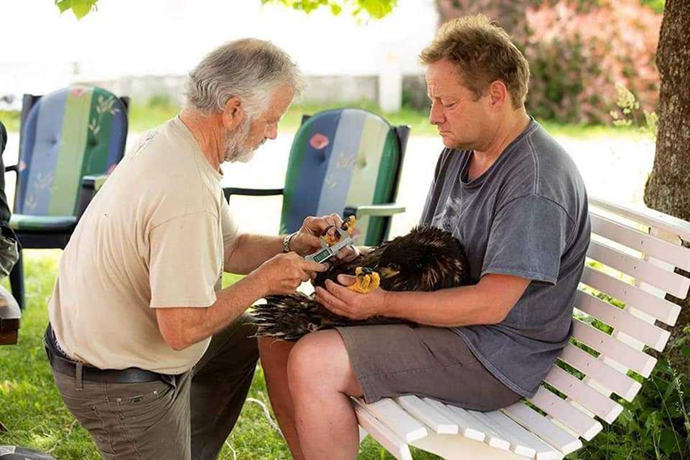
One of the white-tailed eagles chicks being measured by Torgeir Nygård and Tom Roger Østerås in Norway before being transported to Ireland. Photo: NINA
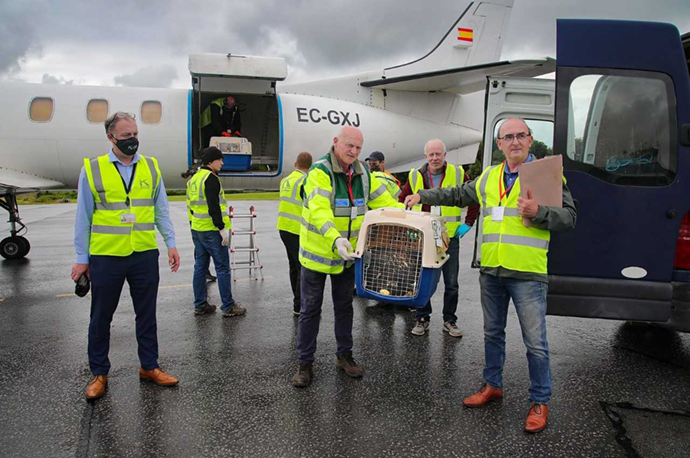
White-tailed eagles’ arrival in Ireland. L-R: Howard Jones, Kerry Airport; Eamonn Meskell, Regional Manager, NPWS; Dr Allan Mee; and Philip Buckley Divisional Manager, NPWS. Photo: Valerie O’Sullivan
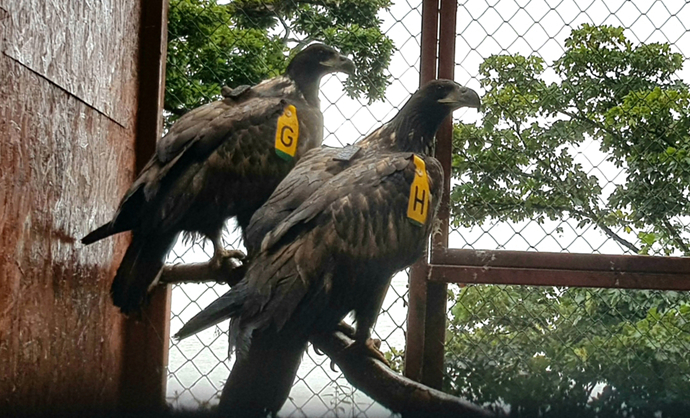
Juvenile white-tailed eagle chicks in an aviary at a release site in Ireland. Photo: NPWS
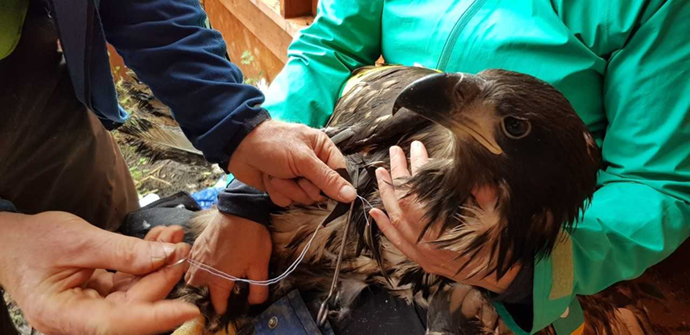
Juvenile white-tailed eagles being fitted with satellite tags by Dr Allan Mee and Alyn Walsh (NPWS) before being released. Photo: Clare Heardman/NPWS
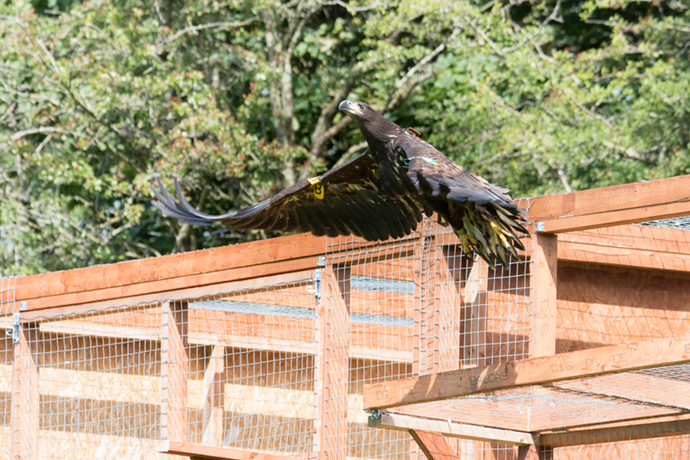
First flight. Photo: Cathal Mullane
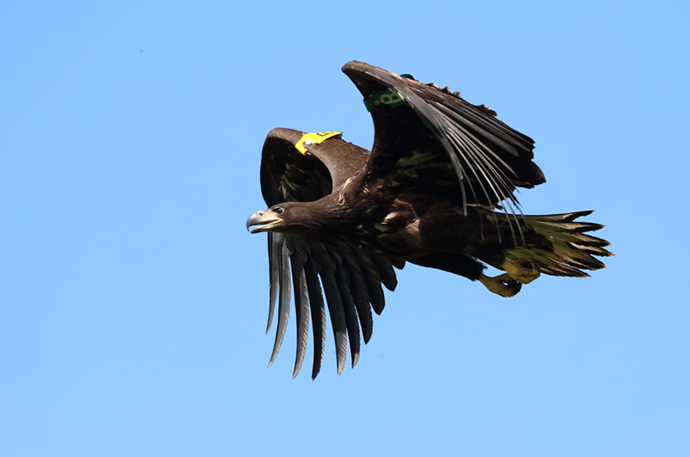
Juvenile white-tailed eagle in flight at Lough Derg. Photo: Robert Foyle
Acknowledgements
The National Parks and Wildlife Service is particularly grateful to following: our Norwegian partners for their vital support; the landowners in Munster for cooperation at the release sites; local businesses for generously donating food for the young eagles (Spillane Seafood, Killarney; Rene Cusack Seafood, Limerick; and Fota Wildlife Park, Cork); the dedicated staff and volunteers who fed the eagles daily in the pre-release cages; and to Dr Allan Mee, for his invaluable expertise.
The Irish White-tailed Sea Eagle Reintroduction Programme is a long-term initiative to re-establish a population of this extinct species in the Republic of Ireland managed by the National Parks and Wildlife Service (NPWS), of the Department of Housing, Local Government & Heritage, in collaboration with others, in particular the Golden Eagle Trust.
For general facts on white-tailed eagles, see the white-tailed sea eagle page on the Glengariff Nature Reserve website.
A live streaming nest camera was set up in 2020 at a nest in Glengarriff, County Cork, by the National Parks and Wildlife Service in collaboration with the Office of Public Works (OPW). The webcam is available for viewing during the breeding season (March to July).
